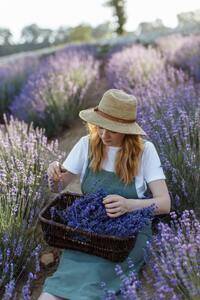Lavender is common name for a genus (Lavandula) of fragrant herbs or shrubs of which a Mediterranean subshrub species (L. spica) is grown for ornament in the garden and for its sweet scent when dried. The dried flowers are used to fill sachets and to perfume clothing or linens. Commercially they, and the green parts, are used for making “oil of spike,” aromatic vinegar, and lavender water.

Historical Usage
Internally, Lavender is historically believed to be of benefit for a multitude of problems, including stress, anxiety, exhaustion, irritability, headaches, migraines, insomnia, depression, colds, digestion, flatulence, upset stomach, liver and gallbladder problems, nervousness, loss of appetite, and as a breath freshener and mouthwash. Inhaling the essential oil in some cases has been reported to work as well as narcotics for inducing relaxation and sleep, easing symptoms of depression, and reducing headache pain. For inhalation purposes, boil 2 cups of water, add 2 drops of essential oil, and inhale the steam.
Safe Essential Oil Usage: Do not take Lavender essential oils internally unless it states on the essential oil that it is food grade and can be taken internally. Essential oils are very potent and often should be used mixed with a carrier oil. It is important to read the bottle label before you buy it. There are a few people allergic to Lavender so be aware of that. Get a book or research essential oils and how to use them safely first. Essential oils used in diffusers can be a problem for some pets so read articles on which oils are cat and dog safe. Some herb plants are not good for animals to eat, especially cats. Read about your oil before buying and using it.
The lavender plant contains a compound called linalool, which can be toxic to animals like dogs and cats.
Essential Oil Usage
Externally, Lavender oil is one of the safest essential oils and can be used full-strength on the skin. It works wonderfully and can be applied directly for cuts, scrapes, wounds, burns, bee, wasp, and insect stings, rashes, muscle aches, rheumatism, arthritis, cold sores, canker sores, blisters, bruises, athlete’s foot, rubbed directly into the temples in case of headache or migraine.
So Many Personal Care and Home Uses
Lavender can be used as an unsweetened tea for a hair rinse to help reduce hair loss and dandruff,
Use the dried flowers in sleep and dream pillows, potpourris, and sachets to give you a relaxing sleep.
Place the dried lavender leaves into drawers to make clothing smell wonderful and to repel clothes moths.
Add a few drops of oil dropped into your warm bath water to relax your body and mind.
The stems with the leaves stripped can be burned like an incense stick, and can also be used in crafts such as basket weaving, and making Lavender wands.
Growing and Harvesting
Bees love Lavender. So do hummingbirds so grow a lot of lavender near your vegetable garden for better crop pollination!
Grow in big tubs to give them lots of room in containers.
There are several lavender species and most are not tolerant to freezing climates. Bring plants into the house in winter or mulch well. It is easiest to grow them from cuttings in Spring from year-old woody stems. Plant the cuttings 4 inches apart and set them in the shade. It takes months for them to root. You can buy Lavender in most nurseries in the Spring to get a head start on the plants.
Plant them in dry, light, well-drained soil that is not too rich. Do not keep wet: Do not let the soil become wet and soggy. This is the greatest enemy of Lavender is wet water-saturated soil. Give them ample room to grow which is about 3 feet between plants. They enjoy full sun unless it is where there are scorching summers like here in the plains of Colorado or Nevada. They love full sun but may need some shade in hot states.
Harvest Lavender early in Spring, when the buds are tight and just starting to open. Pick the lavender early in the morning to get the full essential oil benefits. Picking them in early Spring, you should get another round of beautiful blooms.
For more complete in-depth articles on growing and harvesting Lavender, visit the blogs below.
https://homesteadandchill.com/how-to-harvest-dry-lavender/
https://www.southernliving.com/garden/plants/how-to-harvest-lavender
https://www.therusticelk.com/harvesting-lavender/